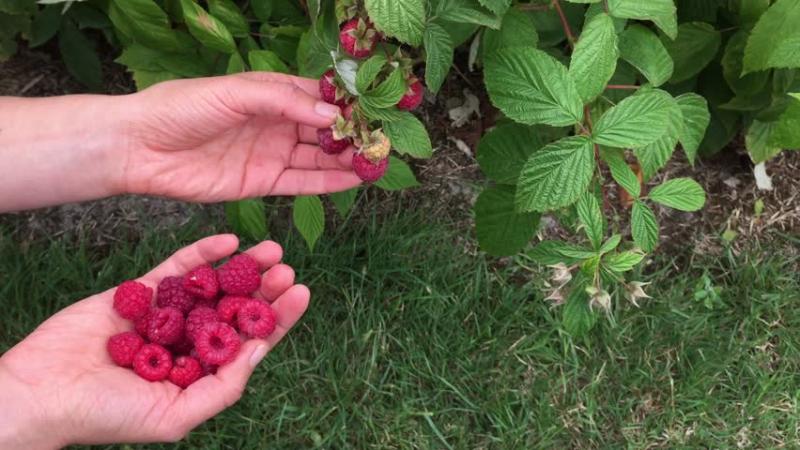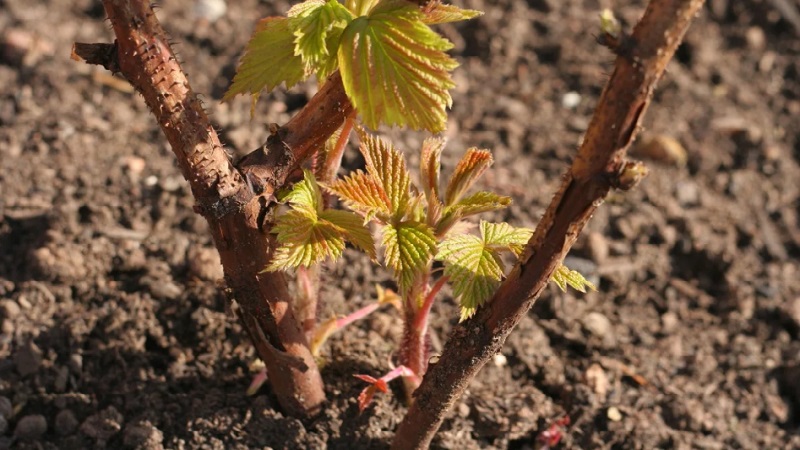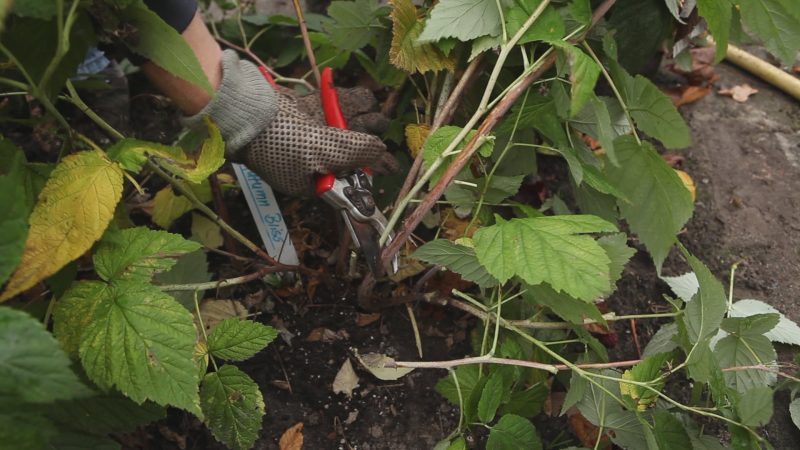Features of caring for raspberries in the Moscow region: how to properly prepare for winter
To obtain a rich harvest of raspberries, plants in the fall are prepared for winter frosts: they are fed, watered, pruned and treated against pests. Subject to the cultivation techniques in the Moscow region, up to 3 kg of berries are obtained from the bush. Consider how to properly prepare the culture for the cold weather and in what time frame.
The content of the article
Agricultural technology for growing raspberries in the Moscow region
Wild raspberries grow wildly in clearings, forest edges, loves open, but protected from the wind places. The same conditions are created for domestic shrubs. The ridges are positioned from north to south so that they are illuminated by the sun all day without being shaded by trees.

Planting raspberries in the Moscow region and care behind her are uncomplicated. The soil should be neutral or slightly acidic. Raspberries love well-fertilized soil. Tomatoes, strawberries and potatoes are not suitable as predecessors: they have common diseases.
The shoots are planted in holes or grooves into which fertilizers have been applied. Plants are tied to a wire stretched between the posts, or a support is placed for each bush.
Care consists in:
- treatment of plants against pests;
- mulching the soil;
- weeding as needed;
- thinning shoots up to 6 pieces per 1 running meter;
- abundant watering;
- the introduction of potassium-phosphorus fertilizers during flowering;
- autumn pruning;
- preparation in winter.
The crop is harvested once every 3 days. Bushes bear fruit for 2 years of life.
When to plant

When is it better to plant raspberries in the Moscow region: in spring or autumn? In mid-latitudes, there is a high risk of severe frosts in winter, therefore, landing in the spring is preferable: from early March to mid-April. If this is not possible, the procedure is postponed to the end of September - mid-October. During this time, the shoots will have time to take root in the ground. Summer is also allowed landing plants in containers with a closed root system.
When raspberries are transplanted in outskirts of Moscow? This is done in the fall, when there are many sprouts of the current year on the bushes. Optimal period: from late August to mid-September. The procedure is especially important for plants that are more than 10 years old. In this case, the old rhizome is removed, and the young growth is transplanted to another place.
How to prepare raspberries for winter in the Moscow region
For the first time, raspberries are cut in June - July when the bushes reach 80 cm in height. The second time it is done in the fall.
Autumn pruning
To increase the yield in the next season, berry fields are formed and the sprouted shoots are removed. The latter continue to draw useful substances from the soil, their roots grow, capturing new areas of the soil. If the branches are not harvested immediately after harvest, they are pruned in the fall.
Important! The bushes are shaped so that all branches have access to light, and the berries grow large and sweet.
The correct formation of the berry plant prevents the development of diseases.
When to trim
It is better to remove the fruit bearing shoots immediately after the return of the crop. Without them, young branches will develop more intensively. The rest of the work is carried out before the onset of frost.
Pruning of two-year-old raspberries is carried out from late August to October, remontant - in late autumn.
How to trim

Use a sharp secateurs.Previously, it is disinfected with alcohol, cologne, alcohol wipes, so as not to bring spores of fungal diseases and viruses to healthy plants.
For disinfection, a solution of copper sulfate is also used (2 tbsp. L for 0.5 l of water), but the metal is not allowed to contact with the reactive medium for a long time.
Instructions and methods of trimming
Pruning a regular two-year-old raspberry consists of several steps:
- All fruit-bearing shoots are removed if this was not done immediately after picking the berries.
- Weak, small and green unripe branches are also removed: they are unlikely to survive the winter, freeze and rot in the spring.
- The raspberries are thinned out, leaving 60 cm between the bushes.
- Branches are removed inside the bushes, which thicken them, leaving 5-8 shoots.
- When planting trellis between the shoots leave 10-15 cm.
- The tops of the tallest plants are cut so that their length is 120–150 cm.
Repaired raspberries are pruned in 2 different ways:
- To get one harvest next year, all shoots are cut to the root in late autumn.
- To harvest two crops, only the branches that have bore fruit are removed, as in conventional varieties.
In raspberries, berries are formed both on the shoots of the last year (in summer) and on new ones (in the fall).
Top dressing
After pruning the bushes, fertilizers are applied: over the summer, the plants greatly deplete the soil, and many useful substances are carried away with the cut out shoots. If raspberries are not fed, the harvest will be poorer every year, and the berries will be smaller.
The best fertilizer is rotted manure. It is brought in about 2 kg per 1 m2 of soil, mixing with 3-5 g of phosphorus and potassium.
If only minerals are used, then 60 g of superphosphate is required, and of potassium salt - 30–40 g per 1 m2.
In order for top dressing to reach the root system, the funds are scattered along a groove dug to a depth of 10-15 cm, at a distance of 20-30 cm from the bush.
Soil treatment
Simultaneously with fertilization, the soil is dug to a depth of no more than 10–12 cm, since the roots of raspberries are located close to the surface.
Before frosts, plants are watered abundantly (2 buckets per bush). The water-saturated soil prevents the roots from freezing. In frosts, in conditions of low humidity, plants are dehydrated, and pre-winter moisture prevents them from drying out.
Pest and disease control
Sick, dried and broken branches are removed - centers of dangerous diseases and the habitat of harmful insects. The soil is carefully dug up.
All leftover leaves removed from the shoots without damaging the buds. To do this, the hand is carefully carried along the trunk from the bottom up.
Important! In order not to injure your hands, be sure to wear gloves.
All plant residues are taken out of the raspberry tree and burned so as not to re-infect the site. With the onset of light frosts, the culture is sprayed with a 2% solution of Bordeaux liquid.
Mulching and bending shoots
Mulch the soil under raspberries throughout the summer, since when loosening it is easy to damage the surface roots. For the winter, the old mulch is removed along with the insect pests that have settled under it.
In severe frosts, when there is no snow, they follow the rules for caring for raspberries at a dacha in the Moscow region.
To protect the roots of plants, the soil is covered:
- straw;
- peat;
- humus;
- coniferous needles.
These materials not only protect raspberries from freezing, but also fertilize the ground. Straw is best used with manure or humus. The needles kill disease-causing bacteria.
When all the work to prepare for winter is completed, one-year-old shoots are bent to the ground so that the snow cover protects them from severe frosts.
This is done in one of the following ways:
- the top of the branch is tied to the base of the adjacent one;
- shoots are bent to the ground and secured with a bracket;
- twine branches together and press them to the ground.
If the branches do not bend well, the procedure is carried out in stages: on the first day, they are bent as much as possible, on the next - even lower.
Attention! Below 40 cm, the shoots do not lower to the soil level: in the snowy spring they will begin to weed out.
The branches are bent until they become brittle, that is, before the onset of frost.
Shelter for the winter
The best hiding place for raspberries is snow. It will cover the shoots bent to the ground and protect them from freezing. If rain falls late, severe frosts will damage unprotected plants. For such cases, polyethylene, spunbond is used.
Above the stems, frames (bent metal rods) are installed, on which the material is pulled in several layers.
The nuances of caring for different types
Care and cultivation of remontant raspberries, ordinary two-year-old and tree-like raspberries in the Moscow region are in many ways similar.
There are some features of cropping and covering:
- if next year they plan to get one harvest of remontant raspberries, in the fall all its shoots are removed at the root (the stems do not have to be bent to the ground);
- from a raspberry tree, the fruiting shoots are removed, they are added dropwise for the winter.
What will happen if you do not cook raspberries for winter
If the winter is warm and snowy, the raspberry tree will not freeze even without bending the branches and shelter, and will give a rich harvest next season. If the winter is frosty and with little snow, there is a high risk of losing berries next year.
Pruning and feeding will benefit the plants and increase their productivity in any weather.
Conclusion
In the autumn, before frost, it is important for plants to return the nutrients that were taken from them with the harvest. For this, mineral and organic fertilizers are applied. The bushes are cut and thinned, covered from severe frosts, disinfected with a Bordeaux mixture. The soil is dug up, moistened and mulched.